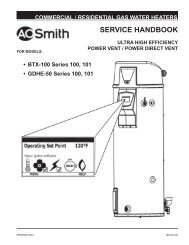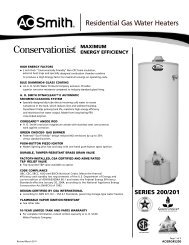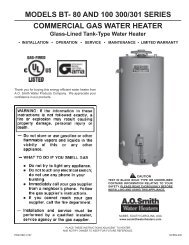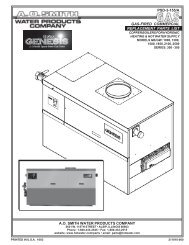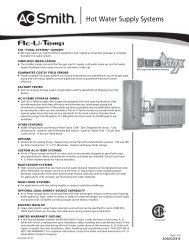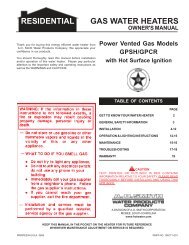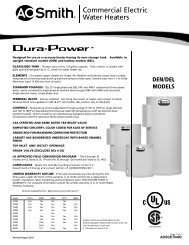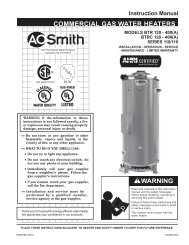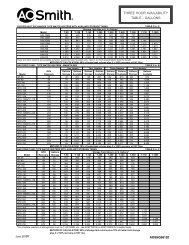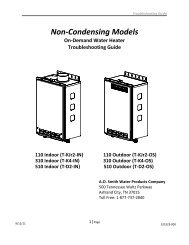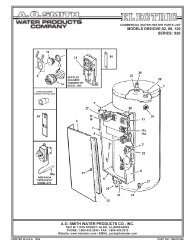322055-000 - AO Smith Water Heaters
322055-000 - AO Smith Water Heaters
322055-000 - AO Smith Water Heaters
Create successful ePaper yourself
Turn your PDF publications into a flip-book with our unique Google optimized e-Paper software.
paragraph. The new valve must be marked with a maximum set<br />
pressure not to exceed the marked hydrostatic working pressure<br />
of the water heater (150 psi = 1,035 kPa) and a discharge capacity<br />
not less than the water heater Btu/hr or KW input rate as shown on<br />
the water heater’s model rating plate.<br />
For safe operation of the water heater, the temperature and pressure<br />
relief valve must not be removed from its designated opening nor<br />
plugged. The temperature-pressure relief valve must be installed<br />
directly into the fitting of the water heater designed for the relief valve.<br />
Install discharge piping so that any discharge will exit only within 6<br />
inches (15.2 cm) above, or at any distance below the structural floor.<br />
Be certain that no contact is made with any live electrical part. The<br />
discharge opening must not be blocked or reduced in size under<br />
any circumstances. Excessive length, over 30 feet (9.14 m), or<br />
use of more than four elbows can cause restriction and reduce the<br />
discharge capacity of the valve.<br />
No valve or other obstruction is to be placed between the relief valve<br />
and the tank. Do not connect discharge piping directly to the drain<br />
unless a 6” (15.2 cm) air gap is provided. To prevent bodily injury,<br />
hazard to life, or property damage, the relief valve must be allowed<br />
to discharge water in adequate quantities should circumstances<br />
demand. If the discharge pipe is not connected to a drain or other<br />
suitable means, the water flow may cause property damage.<br />
The Discharge Pipe:<br />
• Shall not be smaller in size than the outlet pipe size of the valve, or<br />
have any reducing couplings or other restrictions.<br />
• Shall not be plugged or blocked.<br />
• Shall be of material listed for hot water distribution.<br />
• Shall be installed so as to allow complete drainage of both the<br />
temperature-pressure relief valve and the discharge pipe.<br />
• Must terminate a maximum of six inches above a floor drain or<br />
external to the building. In cold climates, it is recommended that the<br />
discharge pipe be terminated at an adequate drain inside the building.<br />
• Shall not have any valve or other obstruction between the relief<br />
valve and the drain.<br />
The temperature-pressure relief valve must be manually operated<br />
at least once a year. Caution should be taken to ensure that (1) no<br />
one is in front of or around the outlet of the temperature-pressure<br />
relief valve discharge line, and (2) the water manually discharged<br />
can cause bodily injury or property damage because the water<br />
may be extremely hot. If after manually operating the valve, it fails<br />
to completely reset and continues to release water, immediately<br />
close the cold water inlet to the water heater, follow the draining<br />
instructions in this manual, and replace the temperature-pressure<br />
relief valve with a properly rated/sized new one.<br />
If you do not understand these instructions or have any questions<br />
regarding the temperature-pressure relief valve call the toll free<br />
number listed on the back cover of this manual for technical assistance.<br />
Closed <strong>Water</strong> Systems<br />
<strong>Water</strong> supply systems may, because of code requirements or such<br />
conditions as high line pressure, among others, have installed<br />
devices such as pressure reducing valves, check valves, and back<br />
flow preventers. Devices such as these cause the water system to<br />
be a closed system.<br />
Thermal Expansion<br />
As water is heated, it expands (thermal expansion). In a closed system<br />
the volume of water will grow when it is heated. As the volume of<br />
water grows there will be a corresponding increase in water pressure<br />
due to thermal expansion. Thermal expansion can cause premature<br />
tank failure (leakage). This type of failure is not covered under the<br />
limited warranty. Thermal expansion can also cause intermittent<br />
temperature-pressure relief valve operation: water discharged from<br />
the valve due to excessive pressure build up. This condition is not<br />
covered under the limited warranty. The temperature-pressure relief<br />
valve is not intended for the constant relief of thermal expansion.<br />
A properly sized thermal expansion tank should be installed on all<br />
closed systems to control the harmful effects of thermal expansion.<br />
Contact a local plumbing service agency to have a thermal expansion<br />
tank installed.<br />
10



